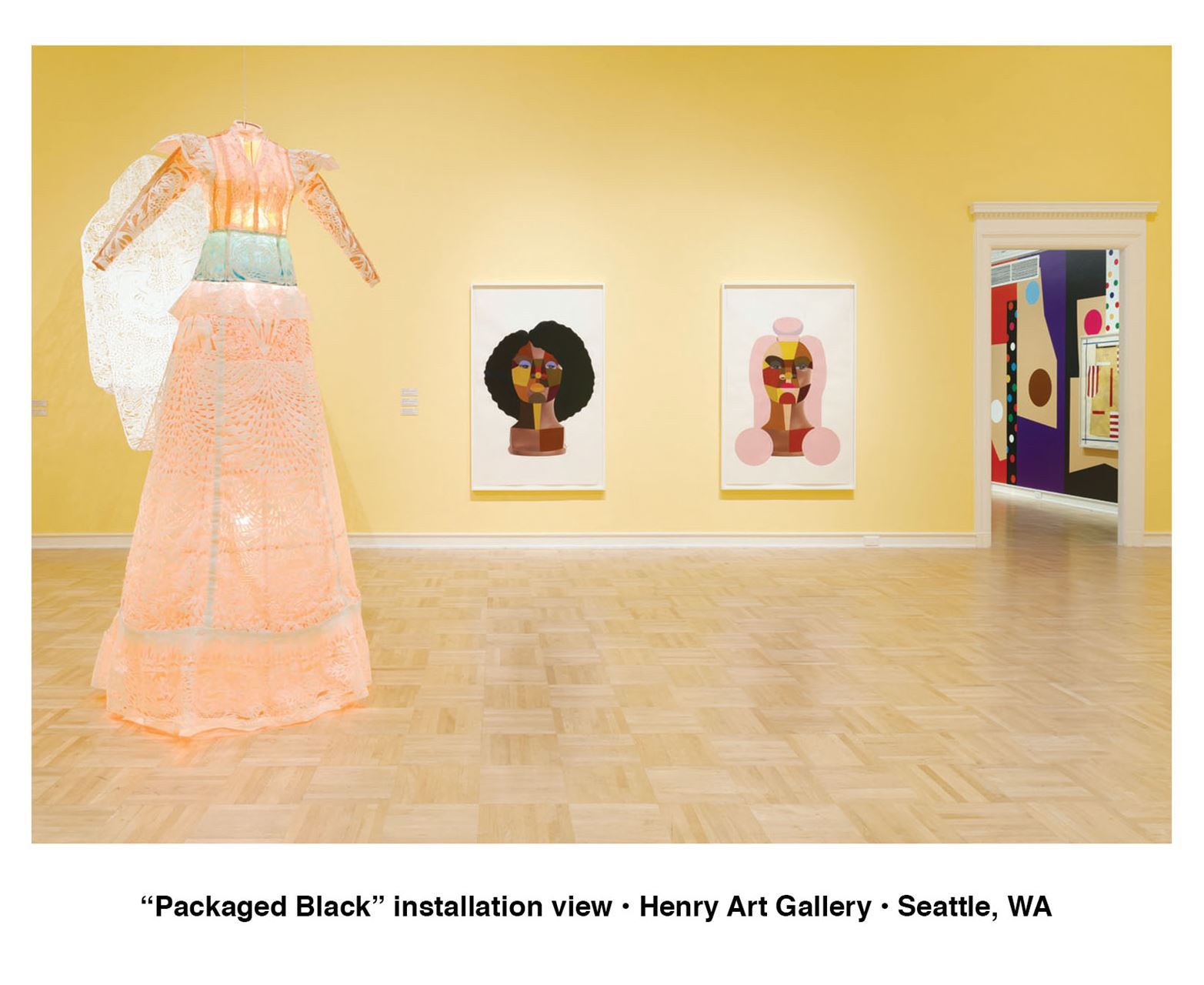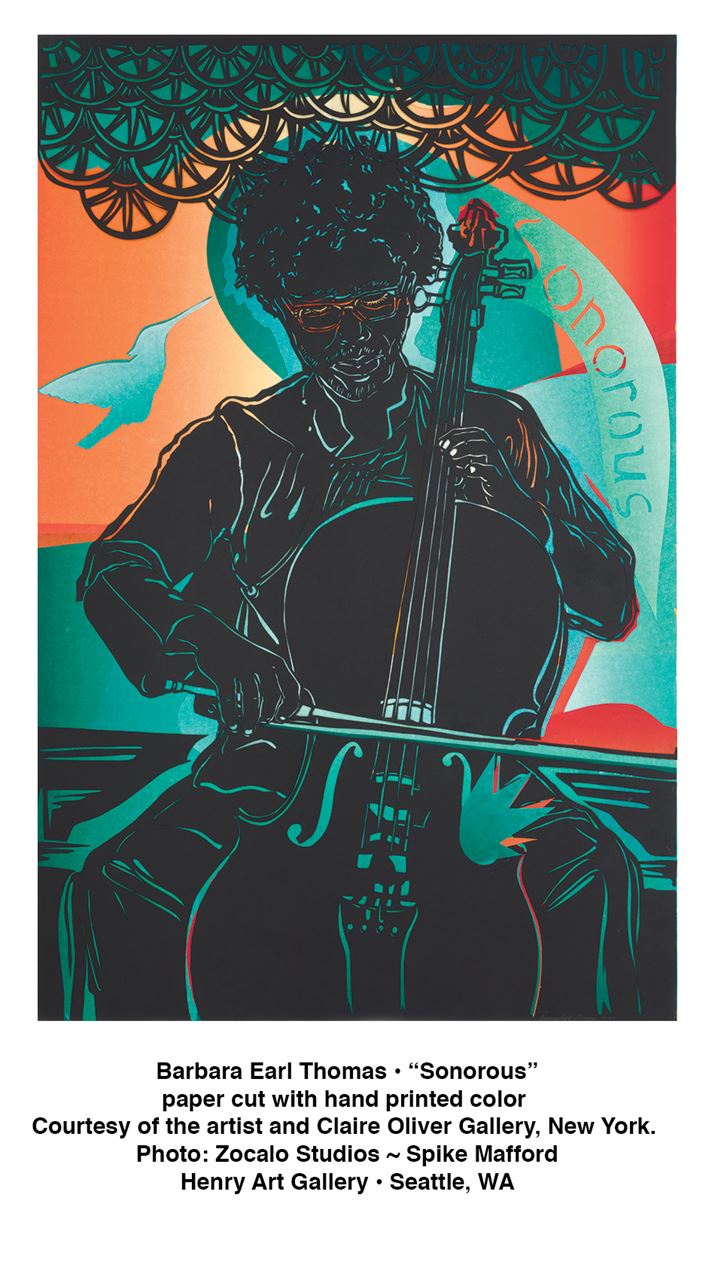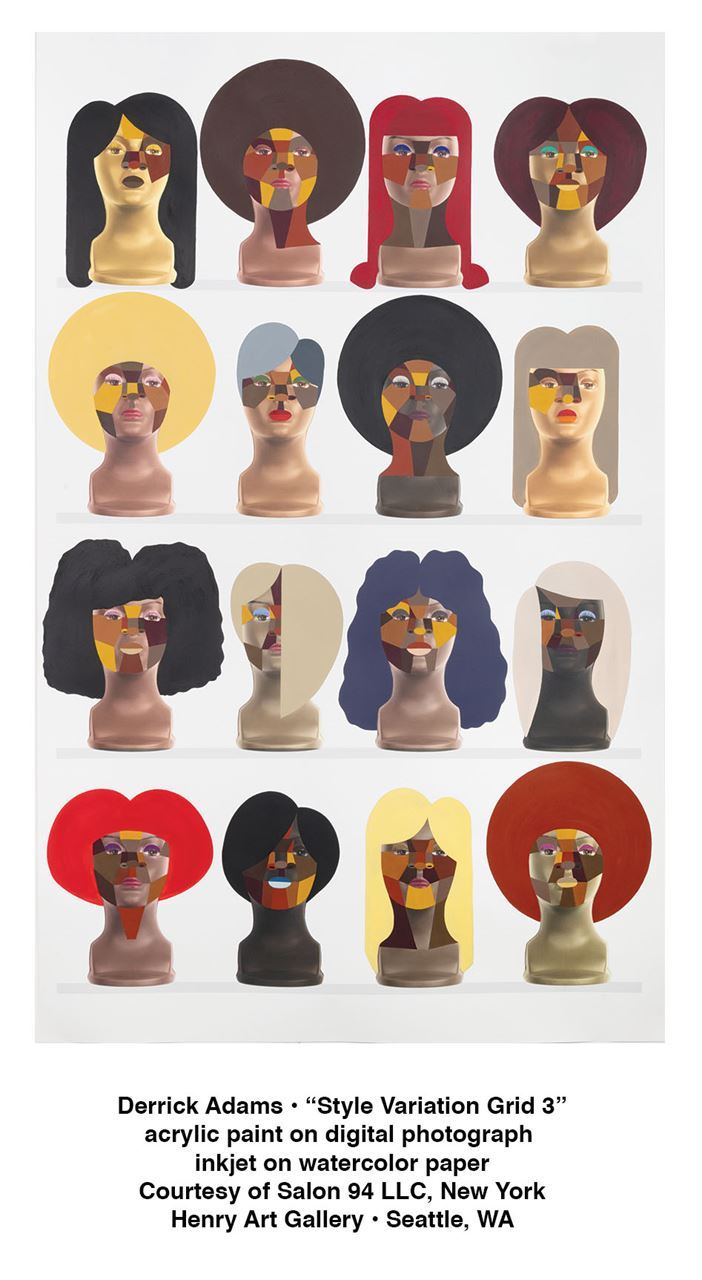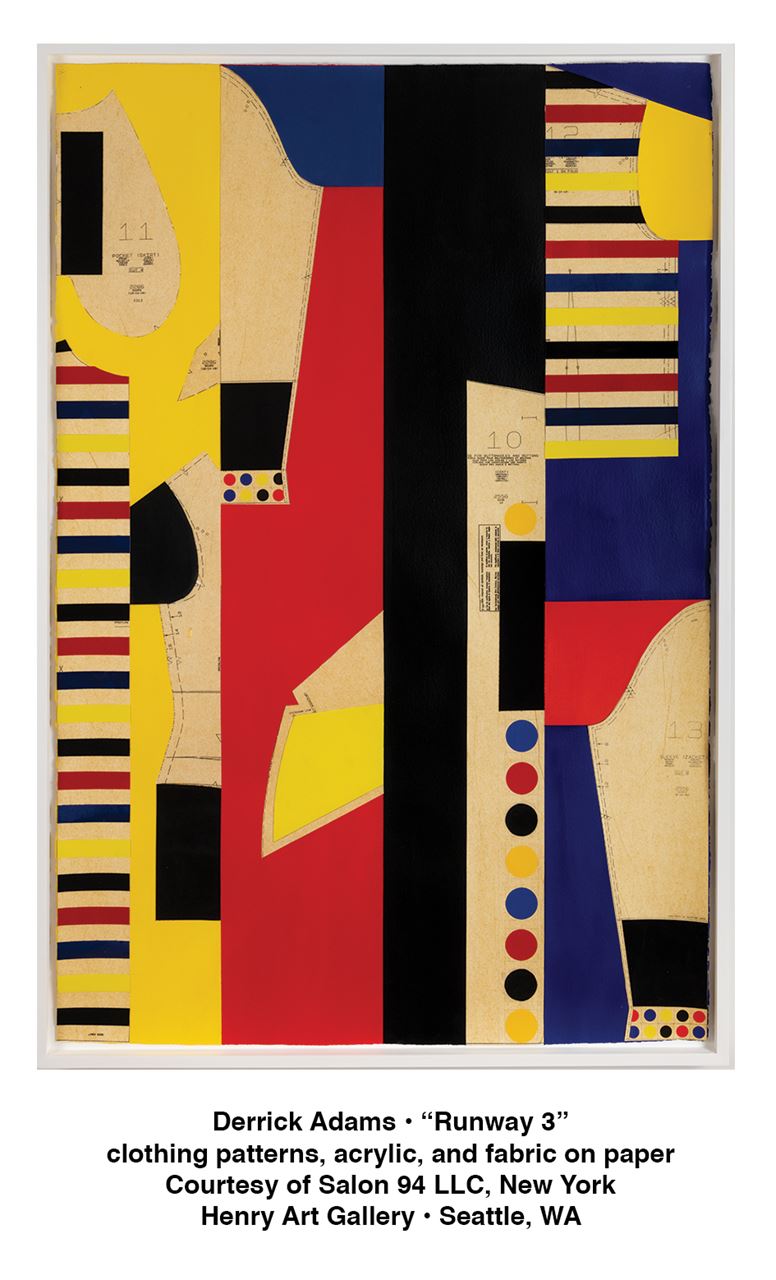
 “Packaged Black” amusingly begins with works in the four niches of the gallery foyer: two tall wire mannequin torsos dressed in skirts of cut out Tyvek by Barbara Earl Thomas and two wig stands with ornate hair by Derrick Adams.
“Packaged Black” amusingly begins with works in the four niches of the gallery foyer: two tall wire mannequin torsos dressed in skirts of cut out Tyvek by Barbara Earl Thomas and two wig stands with ornate hair by Derrick Adams.
The next galleries left and right follow directly on the theme of the foyer. Barbara Thomas features a group of portraits of elegant Black men created with black cut outs against hand printed backgrounds in shades of green highlighted with orange. The men are named by a characteristic, such as “sonorous” or “divine.” A poem on the wall suggests the role of clothing and fashion “Dress up, dress down, dress to kill, dress to chill, dress for success, dress to challenge—it’s a vision, a meditation on the real and the ideal our one chance to magnify or suppress the perceived imperfection of our bodies.” Thomas comments on the crucial importance of dress for African Americans as they step out into the public eye: “ I see fashion as armor, talisman, the magic-cloak, bigger than life.”
In the opposite gallery is Derrick Adams’ video “On,” a send up of late night TV advertising. Against a background of the color bars of old fashioned televisions, performers sell something with no value, such as a box labeled “more for us” “new and improved” promising the “next level” or “extra.” Their cacophony as well as their individual hypes give us hilarious nonsense at the same time that “On” comments on the role of media and branding in colonizing our public personas.
 These two rooms set the stage for the fabulous main gallery and the transformation of the white fairy tale of Cinderella into a glorious African American ensemble. As Thomas states “Cinderella is my gateway dream, the every-person’s story I’ve fashioned black.” First we see a huge, headless Cinderella dressed in a luscious gown of cut out pink Tyvek. Her train fills the center of the gallery. Her royal court includes more of Thomas’s elegant portraits of creative stars and Adams’ homage to black women based on their extraordinary hairstyles. Adams made photographs of mannequins in beauty shops in Brooklyn to which he adds intricate hair styles and mask like faces. Their intriguing individuality contradicts generic media hype.
These two rooms set the stage for the fabulous main gallery and the transformation of the white fairy tale of Cinderella into a glorious African American ensemble. As Thomas states “Cinderella is my gateway dream, the every-person’s story I’ve fashioned black.” First we see a huge, headless Cinderella dressed in a luscious gown of cut out pink Tyvek. Her train fills the center of the gallery. Her royal court includes more of Thomas’s elegant portraits of creative stars and Adams’ homage to black women based on their extraordinary hairstyles. Adams made photographs of mannequins in beauty shops in Brooklyn to which he adds intricate hair styles and mask like faces. Their intriguing individuality contradicts generic media hype.
Adjacent to the main gallery, Thomas lined an entire small gallery with cut out Tyvek floor to ceiling in what she calls “The Transformation Room.” The artist painted the room peach, immersing us in a glow of lacey cut-outs on the walls and even the ceiling. In a shrine-like niche a black and white cut out portrait suggests a young woman transforming herself at a dressing table.
On the other side of the Cinderella gallery Derrick Adams “Changing Rooms” are also about transformation. They feature an homage to Patrick Kelly (1954-1990), the brilliant Black designer who rose to eminence in Paris. Kelly’s fashions based on the vernacular clothes he observed around him going to church as he grew up. He featured patterns, and materials, especially buttons, that transformed couture fashion. In Adams’ homage, the artist creates a series of “Runway” works: mixed media collages with clothing patterns, and painted polka dots and stripes, to evoke Kelly’s transformations.
 In the back room of the exhibit, the two artists collaborated on “Rotating Lantern,” a ceiling light (evoking the mirror ball of a nightclub) that projects alternate cut outs from each of their work. It suggests a party for all of these transformed people, and we are the people having fun.
In the back room of the exhibit, the two artists collaborated on “Rotating Lantern,” a ceiling light (evoking the mirror ball of a nightclub) that projects alternate cut outs from each of their work. It suggests a party for all of these transformed people, and we are the people having fun.
Just before the entrance to “Packaged Black” is “Viewpoints: Queer Visibility,” two starkly contrasting paintings. “Boyz of the Wild” by Anthony White is a lusciously detailed expression of male desire painted with a sensuous surface created by polylactide (a thermoplastic made from renewable resources). Facing it is Dean Sameshima’s “Torso (Black on Silver)” a seemingly reductive black and white flow chart until you look more closely! The exhibition includes several poetic responses by members of the community including Jasmine Fetterman’s “A Letter Written in Queer Longing” a beautiful evocation of desire.
On the lower level of the Henry, Syrian-born artist Diana Al-Hadid’s “Archive of Longing” exhibit presents extraordinary sculptures that evoke the destruction of culture. The artist created “Blind Busts” blindfolded. The face is generic, the figure sits on a bizarre pedestal that suggests dripping mud (it is bronze). Another work, “Smoke and Mirrors” leans dangerously as it seems to disintegrate before our eyes.
At the moment the entrance is pay what you wish!
Susan Noyes Platt
Susan Noyes Platt writes a blog www.artandpoliticsnow.com and for local, national, and international publications.
“Packaged Black: Barbara Earl Thomas and Derrick Adams” is on view through May 1, at the Henry Art Gallery from Thursday, 10 A.M. to 7 P.M., and Friday through Sunday, 10 A.M. to 5 P.M. Visit www.henryart.org for more information.